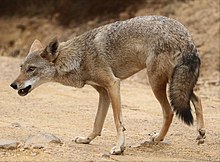
Back وعوع Arabic ديب إفريقي ARY Златист вълк Bulgarian Llop daurat africà Catalan Canis anthus CEB Vlk africký Czech Африка ылтӑн кашкӑрӗ CV Afrikanischer Goldwolf German Αφρικανικός χρυσός λύκος Greek Canis anthus Basque
| African wolf Temporal range: Middle Pleistocene – Recent 0.6-0 Ma
| |
|---|---|

| |
| African wolf in Haizer, Algeria | |
| African wolves howling | |
| Scientific classification | |
| Domain: | Eukaryota |
| Kingdom: | Animalia |
| Phylum: | Chordata |
| Class: | Mammalia |
| Order: | Carnivora |
| Family: | Canidae |
| Genus: | Canis |
| Species: | C. lupaster
|
| Binomial name | |
| Canis lupaster | |
| Subspecies | |
| |

| |
| Synonyms | |
The African wolf (see below for other names; Canis lupaster) is a canine native to North Africa, West Africa, the Sahel, northern East Africa, and the Horn of Africa. It is listed as least concern on the IUCN Red List.[1] In the Middle Atlas in Morocco, it was sighted in elevations as high as 1,800 m (5,900 ft).[3] It is primarily a predator of invertebrates and mammals as large as gazelle fawns, though larger animals are sometimes taken. Its diet also includes animal carcasses, human refuse, and fruit. They are monogamous and territorial; offspring remain with the parents to assist in raising their parents' younger pups.[4]
The African wolf was previously classified as an African variant of the golden jackal (Canis aureus), with at that time at least one subspecies (C. a. lupaster) having been classified as a wolf. In 2015, a series of analyses on the species' mitochondrial DNA and nuclear genome demonstrated that it was, in fact, distinct from the golden jackal, and more closely related to the gray wolf and the coyote (Canis latrans).[5][6] It is nonetheless still close enough to the golden jackal to produce hybrid offspring, as indicated through genetic tests on jackals in Israel,[5] and a 19th-century captive crossbreeding experiment.[7] Further studies demonstrated that it is the descendant of a genetically admixed canid of 72% gray wolf (Canis lupus) and 28% Ethiopian wolf (Canis simensis) ancestry.[8]
It plays a prominent role in some African cultures; it was considered sacred in ancient Egypt, particularly in Lycopolis, where it was venerated as a god. In North African folklore, it is viewed as an untrustworthy animal whose body parts can be used for medicinal or ritualistic purposes,[9][10][11] while it is held in high esteem in Senegal's Serer religion as being the first creature to be created by the god Roog.[12]
- ^ a b c Hoffmann, M. & Atickem, A. (2019). "Canis lupaster". IUCN Red List of Threatened Species. 2019: e.T118264888A118265889. doi:10.2305/IUCN.UK.2019-1.RLTS.T118264888A118265889.en. Retrieved 19 November 2021.
- ^ Cite error: The named reference
cuvierwas invoked but never defined (see the help page). - ^ (in Spanish) Moliner, V. U., Ramírez, C., Gallardo, M. & Idrissi, H. R. (2012), "Detectan el lobo en Marruecos gracias al uso del foto-trampeo", Quercus, 319:14–15, ISSN 0212-0054
- ^ Estes, R. (1992). The behavior guide to African mammals: including hoofed mammals, carnivores, primates. University of California Press. pp. 398–404. ISBN 0-520-08085-8.
- ^ a b Cite error: The named reference
koepfli2015was invoked but never defined (see the help page). - ^ Cite error: The named reference
urios2015was invoked but never defined (see the help page). - ^ Cite error: The named reference
cuvier3was invoked but never defined (see the help page). - ^ Cite error: The named reference
gopalakrishnan2018was invoked but never defined (see the help page). - ^ Osborn, D. & Helmy, I. (1980). "Canis aureus lupaster (Hemprich and Ehrenberg, 1833)". The contemporary land mammals of Egypt (including Sinai). Chicago: Field Museum of Natural History. pp. 360–371.
- ^ Cite error: The named reference
bidwell2005was invoked but never defined (see the help page). - ^ Cite error: The named reference
westermarck2013was invoked but never defined (see the help page). - ^ Cite error: The named reference
gavrand1990was invoked but never defined (see the help page).
© MMXXIII Rich X Search. We shall prevail. All rights reserved. Rich X Search
